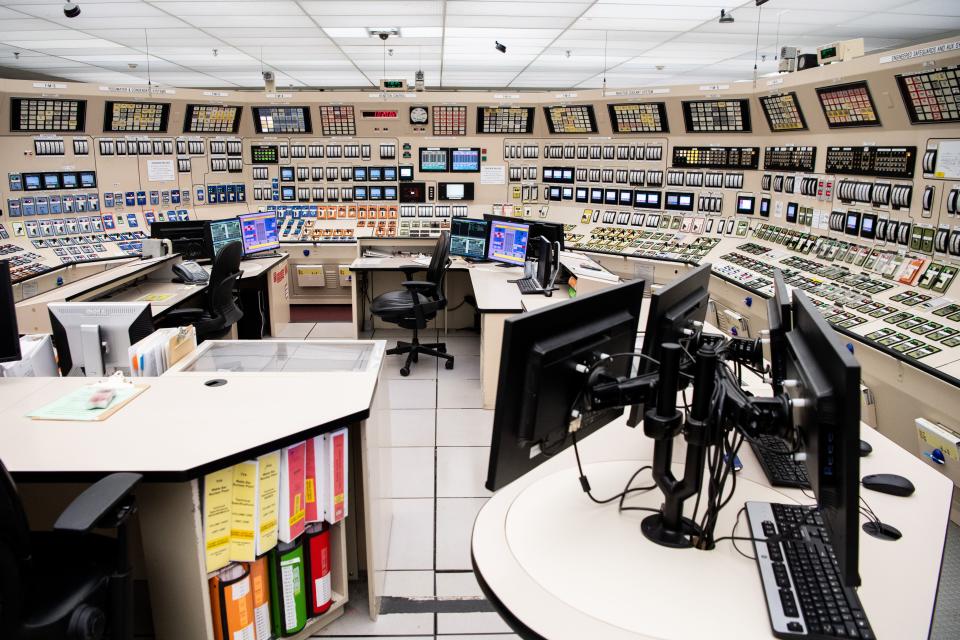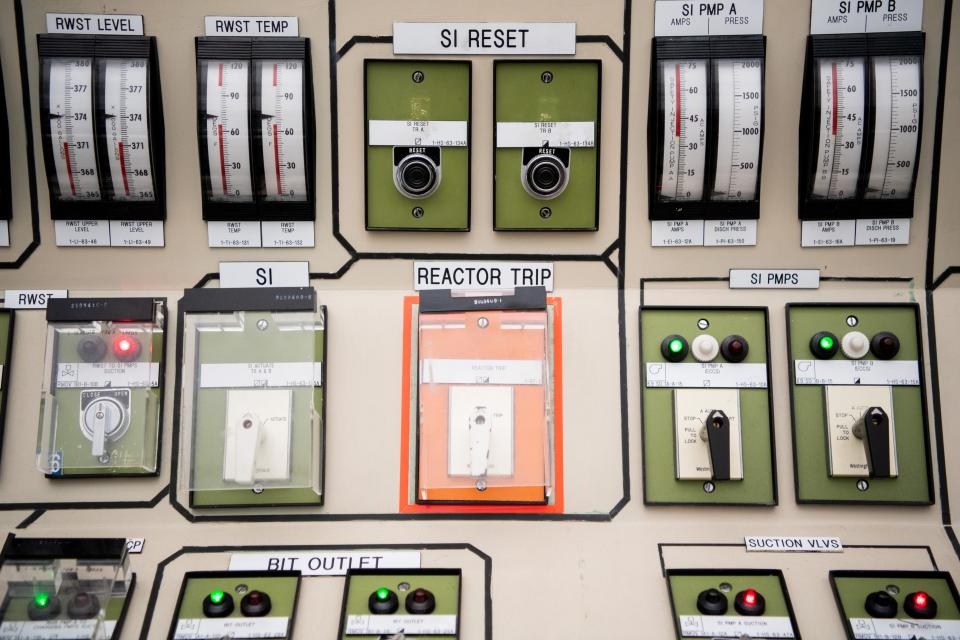TVA prepared in case of an emergency at Watts Bar Nuclear Plant; its neighbors should be, too
Living near a nuclear power plant might sound scary, but "actually one of the safest place in the world to be is at a nuclear power plant," Tennessee Valley Authority's public information office Jim Hopson declared recently.
Every year, TVA releases updated emergency prep information to residents within a 10-mile radius of its nuclear power plants, including Watts Bar in East Tennessee. The information is published in a calendar residents can keep in the event they need to know how they would be notified of an emergency, evacuation routes and a checklist of items to have. TVA also hosts meetings with local media, such as Knox News, to share information on emergency protocols.
"Anyone who works here understands it because we have the most concentrated source of energy available to civilians under our control," Hopson said during a presentation in early December. "We know what we're dealing with; it's one of the reasons why we go to incredible lengths to ensure the public is safe, because we know how dangerous it could be if we don't do our jobs right."
The Watts Bar Nuclear Plant is located on the edge of Rhea and Meigs counties, about halfway between Chattanooga and Knoxville. The plant opened in 1996 and can supply enough electricity to power 1.3 million homes. According to the 2020 U.S. Census, the counties near Watts Bar - Rhea, Meigs and McMinn - all have seen population growth.
More:TVA plan details option to demolish Bull Run power plant
What are TVA's safeguards against an emergency?
All of TVA's nuclear power plants are regulated by the Nuclear Regulatory Commission, while TEMA and local EMAs respond to the Federal Emergency Management Agency.
The two federal agencies not only conduct inspections but also graded exercises of real life scenarios that both TVA and TEMA would have to handle. If an emergency were to occur, these agencies would hold TVA and TEMA accountable. The NRC has four specific emergency classifications that would guide TVA's actions on how to handle an emergency.
"We simulate breaking things in the plant so we can drive them to declare emergencies and it actually is pretty hard to get to the point where they would have to declare a general emergency, which is the highest level of emergency classification," Mike White, TVA's site emergency preparedness manager, said. "Because of the way the plant takes care of itself, because of all of the backup systems, the operator actions that take place in here actually make it very difficult for us to craft our drills that are going to take us to general emergency."
TVA has an on-call emergency response organization. Those on duty who are notified of an emergency have 90 minutes to respond.
The plant is programmed to take care of itself, monitor every situation and notify operators if something changes. A team of operators works in a control room checking the plant's operations for any abnormalities.

"A 747 pilot has to undergo 24 hours of simulator training every two years in order to maintain their air transportation certificate - in other words, their license to fly those big planes. Your cardiac surgeon has to undergo one week of training every five years in order to operate on your heart," Hopson said. "Licensed nuclear operators undergo one week of training every five weeks."
Training is continuous at the plants. Watts Bar has a simulated control room where operators learn from nuclear incidents in other countries, do routine training and analyze their responses.
Every switch that is pulled in both the simulated and actual control rooms is recorded and backed up to a computer. A plant operator's response time to an emergency can be seen and recorded down to the millisecond. If an emergency takes place, the data can be retrieved and analyzed either for regulatory purposes or for learning. Every action is watched very closely to ensure safety.
The plant also monitors its radiation releases. While radiation is naturally occurring in the environment, TVA does not want to expose Watts Bar's neighbors to its operations. Every worker wears a dosimeter that monitors the amount of radiation to which they have been exposed over time. If workers are in areas where they are more likely to be exposed to radiation, such as reactor buildings, they wear monitors that will give them real-time readings.
Hopson said the U.S. measures radiation exposure in millirems. For every X-ray a person gets at the dentist, they are exposed to about five millirems. A chest X-ray would be 20 millirems.
"The average dosage from U.S. nuclear power for anyone who lives right on the plant boundary - in other words if you live [or] you stood by the plant boundary for 365 days - you would get one millirem," Hopson said.
Oak Ridge: $300M investment ushers in new era of nuclear power with 'gumball' technology
How does the Watts Barr Nuclear Plant make electricity?
Currently, nuclear energy is the only carbon-free energy source that utilities can use 24 hours a day, seven days a week, regardless of weather. TVA has three nuclear power plants, including Watts Bar. As TVA moves toward becoming carbon-neutral, it has said it will rely on nuclear more. This includes its research and development of small modular nuclear reactors.

Watts Bar uses uranium, which undergoes a reaction that releases heat. The heat is used to turn water taken in by the plant into steam. Much like in a coal-fired plant, the steam turns a turbine, which generates electricity. The uranium is in the form of pellets that are sealed in metal rods.
"One nuclear fuel pellet, that one little bitty nuclear fuel pellet, has the same energy equivalent as one ton of coal," Hopson said. "So think about millions of that in a reactor. That's how much energy licensed operators control every single day."
After the reaction takes place and TVA is done with the fuel rods, it cools them in water. The water insulates the radiation emitted from the rods during the cooling process. Once cooled, the rods are put into dry, insulated metal and cement casks that are intended to last about 200 years.
As it has been for the plant's its 30 years of operation, Watts Bar's nuclear waste is sealed in these casks and takes up less than an acre of above-ground land. Plant operators check the casks daily. This disposal process is used across the industry while utilities like TVA await the Department of Energy's final solution on how to dispose of nuclear waste.
Anila Yoganathan is a Knox News investigative reporter. You can contact her at anila.yoganathan@knoxnews.com, and follow her on Twitter @anilayoganathan. Enjoy exclusive content and premium perks while supporting strong local journalism by subscribing at knoxnews.com/subscribe.
What Watts Bar neighbors should know before an emergency
Informational calendars and cards
Every year TVA sends out updated calendars that contain emergency plans, contacts and information about the plant to residents who live within a 10-mile radius of Watts Bar. TVA recommends residents keep their calendars in a place they can access for easy reference. TVA offers an online version of the calendar in Spanish.
Included with the calendars are cards that residents can fill out to notify TVA ahead of time if they would need help in the event of an emergency, such as if a resident or family member is disabled. The cards also are provided in Spanish.
Sirens and social media
TVA has about 101 sirens located within a 10-mile radius of the plant. The sirens might be individually tested throughout the year but the full system is tested at noon the first Wednesday of every month. If the sirens go off, TVA recommends residents check whether there are any scheduled tests going on; if not, residents can check their local radio or TV station for the emergency alert system and more information on a potential emergency: WUSY-FM (100.7) in Chattanooga and WIVK-FM (107.7) in Knoxville.
The sirens and alert system do not necessarily mean residents should evacuate: if an emergency were serious enough, TEMA would issue updates on its social media accounts with information, but radio could serve as a reliable source, too.
Which agencies would oversee what
TVA partners with the Tennessee Emergency Management Agency and local Emergency Management Agencies in Rhea, Meigs and McMinn counties to handle a potential emergency at Watts Bar. While TVA would handle any issues at the plant and communicate the severity to the state and local EMAs, the state and local EMAs would communicate to the public about actions such as evacuation. Tim Holden, the technical hazards administrator for TEMA, said the local EMAs are robust in their training and protocols because of their proximity to Watts Bar.
Find more information online
TVA's emergency preparedness recommendations also are available online:
TVA's general recommendations: https://www.tva.com/energy/our-power-system/nuclear/emergency-preparedness
Information for the area around Watts Bar: https://www.tva.com/energy/our-power-system/nuclear/emergency-preparedness/watts-bar-emergency-preparedness
This article originally appeared on Knoxville News Sentinel: TVA updates Watts Barr residents on nuclear plant emergency prep
